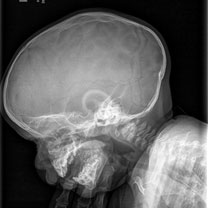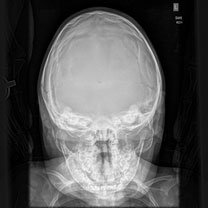Craniosynostosis
Craniosynostosis describes a cranial deformation due to premature fusion/closure of cranial sutures. These sutures in the skull bones are to be understood as the growth plates of the head. The brain undergoes a very rapid growth during the first months of life. This rapid growth ends after the age of 2, the cranial sutures then can close naturally. The ossification is completed by age 6 to 8 years.
In the case of premature closure of individual cranial sutures, the skull cannot expand in the direction of fused suture, but grows in the directions of still open sutures. This can lead to the initially mentioned deformities, but sometimes also to an unnatural increase in intracranial pressure. Typical deformities arise depending on the affected suture. For example, in case of the premature closure of the sagittal suture, which runs longitudinally over the head, it comes to an exaggerated length growth accompanied by handicapped width growth. The result is a very long and narrow configuration of the skull (Scaphocephalus, see picture)


X-ray representation of a scaphocephalus with narrow and long form of the head, with premature closure of the sagittal suture.
The exact cause is unknown; several factors such as disorders of bone metabolism, changes in the skull base, intrauterine problems and genetic disorders may play a role. Furthermore, around 50 complex diseases patterns (syndromes) are known, where craniosynostosis can occur in different forms. Treatment is usually surgical correction, whereby the cosmetic aspect is the most important aspect, because significant cranial deformities often lead to stigmatization and social exclusion. Especially when multiple sutures are affected at the same time, elevated intracranial pressure has to be considered as a result of a skull volume which is too small. The surgical correction should take place between the 7th and 12th month of life.




